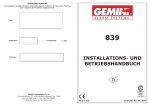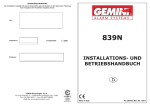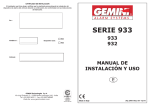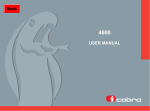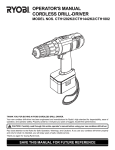Download End user manual Manuale utente Manual usuario - Gemini
Transcript
CERTIFICATO DI INSTALLAZIONE Il sottoscritto,installatore,certifica di aver eseguito personalmente l'installazione del dispositivo di allarme del veicolo descritto qui di seguito, secondo le istruzioni del fabbricante. INSTALLATION CERTIFICATE The undersigned,qualified installer,attests to have personally fitted the here described Vehicle Security sistem following the manufacturer instructions. CERTIFICAT D' INSTALLATION Je soussigné,installateur,certifie d'avoir fait personnellement l'installation du dispositif d'alarme du véhicule ci décrit,conforme aux instructions du constructeur. EINBAUBESCHEINIGUNG Der Installateur bestätigt mit seiner Unterschrift, dass die Alarmanlage in dem genannten Fahrzeug nach Vorgaben Des Herstellers eingebaut wurde. CERTIFICADO DE INSTALACION El que suscribe, instalador certifica el haber personalmente la instalación del dispositivo de alarma del vehículo descrito a continuación, de acuerdo con las instucciones del fabricante. CERTIFICADO DE INSTALAÇÃO O abaixo assinado, instalador, certica que executou pessoalmente a instalação do dispositivo de alarme do veículo descrito a seguir, conforme as instruçoes do fabricante. By : Da : Par Von: Por : De: Venduto il : Sold on : Vendu le : Verkauft am: Vendido el : Vendido em: Auto Car Véhicule Fahrzeug Veículo ................................... Tipo di prodotto : Type of product : Type de dispositif: Produktartikel: Dispositivo ciclo: Tipo de dispositivo: 7590 End user manual Manuale utente Manual usuario ........................................................... Firma, Signature, Unterschrift, Assinatura .......................................................................................... by GEMINI Technologies S.p.A. Via Luigi Galvani 12 - 21020 Bodio Lomnago (VA) - Italia Tel. +39 0332 943211 - Fax +39 0332 948080 Web site: www.gemini-alarm.com - e-mail: [email protected] For all EU countries AC 2594 rev. 01-09/05 UK INTRODUCTION The 7590 system is a alarm control unit with built-in sensors and can be installed on cars having a 12-volt battery with the negative pole earthed. GENERAL NOTE FOR INSTALLATION Dear installer, this manual has been conceived and written keeping in mind the complete system. Therefore some functions, electrical connection and other can be present in one alarm version and lack to another. In order to avoid useless repetitions in the manual, before installing the available alarm, you are kindly requested to verify its version and then follow the suitable instructions. Furthermore, in order to carry out correctly the various procedures required, we remind you to make and to verify very carefully all electrical connections, IN PARTICULAR THE BASIC CONNECTIONS: !Device power supply (positive and earth) !Positive under key (+15/54) !Door switch !Bonnet or Trunk switch FUNCTIONS !Arming and disarming of the alarm system with transmitters having random rolling code. !Electrical engine immobilizer by passive arming. !Double engine immobilizer. !Blinker. !Sirene sound intermittent or continuous (programmable). !Perimetric protection. !Volumetric protection (combined with an ultrasonic or hyperfrequency module, excludable from arming). !Control for CDL, electrical widows and sun roof (vehicles equipped with the system “Pack-comfort”). !Alarm memory indicated by optic/acousticl signals. !“PANIC” or “BOOT OPENING” function (programmable). !Current absorption sensor (programmable). !Anti distraction function (programmable). !Control for self-powered siren or supplementary siren. !Emergency disarming by PIN-CODE. !Garage function. PAG. 2 TOTAL ALARM ARMING The alarm can be activated by pressing key 1 on the remote or by inserting the electronic key into the appropriate socket. The operation is confirmed by an acoustic signal and a visual signal consisting of one flash of the turn indicators lasting approximately one second. During the flash, the following functions are enabled: a-Module output (PINK wire, +A). b-Led output. c-Engine immobilizer. d-Activation of door-locking control (with the timing selected in programming phase). If the electronic key is used, all the functions described under points a), b) and c) will be activated, whereas d) ACTIVATION OF DOOR-LOCKING CONTROL will not occur (enabling the user to get out of the vehicle). Moreover, by using the electronic key, a car entry time of approximately 10 seconds will be generated to allow the user to get into the car and deactivate the alarm system with the electronic key without creating a false alarm. While the user gets into the car, entry time is indicated by the continuous light of the LED. NEUTRAL TIME, SENSOR EXCLUSION , STOPPING WINDOW UPWARD TRAVEL AND COMFORT FUNCTION Neutral activation time lasts approx. 35” and it is indicated by the continuous light of the LED. This time interval allows the user to get out of the vehicle without causing false alarm conditions. During the first 25” of the neutral time, it is possible to cut out the external sensors and stop the windows' upward travel by pressing key no. 2 on the remote (Note: the stop window function requires the installation of a special module see art. 2344 or the existence of the COMFORT function in the car). The activation of said functions (Cutting out the external sensors / stopping window upward travel / comfort) is indicated by a brief flash of the turn indicators. NOTE: sensor cutout is limited to a single alarm activation cycle. ARMING WITH SIREN SOUND EXCLUSION This function allows the user to arm the alarm system, excluding the siren sound in case of a theft attempt. To exclude the siren, proceed as follows: !Turn the ignition key to “ON” position !The status will stay on for 0,5 seconds. During this time, push the button N°2 of the transmitter. !Go away from the vehicle and push the button N°1 of the transmitter. !The alarm will be armed with the optical and acoustic signals, which, as previously described, will be not activated in case of a theft attempt. NOTE: the siren sound exclusion is bound to the single arming cycle. PAG. 3 NEUTRAL TIME At the end of each alarm cycle there is a neutral time period, lasting up to approx. 5”, during which there will be no reaction to the causes of alarm. During the neutral time between successive alarms, the LED will emit a continuous light. Normal flashing will be resumed at the end of the neutral time. SYSTEM ARMED AFTER NEUTRAL TIME At the end of the neutral time (approx. 45”), the security system is completely armed and ready to intervene in cases of attempted theft or sabotage. Completely armed status is indicated by the flashing of the LED, which will wok according to the following timing scheme in order to minimise power consumption: LED ON : 200mS LED OFF : 2” EVENTS THAT CAN GENERATE AN ALARM CONDITION !System wire cutting by means of the self-powered siren !Attempt to start the engine. !Power drained. This function is active only if enabled in the accessory function programming phase and can be used only in countries where the law does not prohibit the use of this sensor. !Attempt to open the doors. !Attempt to open boot. !Attempt to open engine bonnet. !Intrusion detected by internal ultrasound volume sensor. !Intrusion detected by external sensors (option,also by radio). !Panic alarm by pressing key no. 2 on the remote (this function is active only if enabled in the accessory function programming phase and it can be used only in countries where the law permits this type of alarm activation not available in product version for the dutch market). NOTE: In order to filter noise and/or undesired signals, the POSITIVE UNDER KEY, DOORS and BOOT PUSH-BUTTON inputs have a DEBOUNCE time of 200mS. Therefore these inputs will cause the generation of an alarm cycle only if the signals coming in last longer than 200mS. For every input and every arming cycle, the alarm causes are limited to 10 cycles of 30 seconds each. The only alarm causes having no limits, is starting attempt (positive under key +15/54). ALARM DISARMING The alarm system can be deactivated by pressing key 1 on the remote, by inserting the electronic key into the appropriate receptacle or by means of the emergency PIN CODE procedure. Disarming is indicated by three turn signal flashes and three acoustic signals. If an alarm condition has occurred, it will be signalled by five turn signal flashes and five acoustic signals (if these functions have not been excluded in programming stage). See next paragraph for all signalling. PAG. 4 ALARM MEMORY When disarming the alarm, if five turn signal flashes and five beep signals occur, it is possible to identify the cause generating the alarm condition. To do this, turn the ignition key to “ON” position and look at the vehicle installed LED. The LED will be blink, shown the last alarm condition. The cause of the alarm will indicate for 5 times, and this indication can be interrupted by turning the ignition key to “OFF” position. The possible alarm signalling are indicated in the table below. LED SIGNAL LED OFF (2 seconds) NUMBERS OF ALARM CYCLES Volumetric sensor 5 Doors/boot switches 5 Positive under key (+15/54) Infinite Bonnet switch and 5 volumetric sensors Absorption sensor 5 External magnetic contact 5 CAUSE OF THE ALARM LED ON (400mS) NOTE: the cause of alar of CUT WIRE does not enabled the alarm memory because it is managed by the external self-powered sirene. SUPPLEMENTARY SIREN OPERATION Continuous audible signal for the entire duration of the alarm signal cycle. ORIGINAL HORN OPERATION Intermittent sound 2” ON 2” OFF for the entire duration of the alarm signal cycle. If the user has cut out the siren, the alarm condition will be indicated solely by the flashing of the turn indicators for a maximum time period of 30”. NOTE: While the alarm signal is given out, the LED will emit a continuous light. You can cut off the alarm cycle without deactivating the system, by pressing key no. 2 on the remote. As you do so, the audible/visible alarm signals will be immediately cut off, and the system will switch to the condition of NEUTRAL TIME BETWEEN SUCCESSIVE ALARMS. To minimise acoustic pollution, the DOORS PUSHBUTTON, BOOT PUSHBUTTON, BONNET PUSHBUTTON, ELECTRICAL INPUT SENSOR, INTERNAL VOLUME SENSOR and EXTERNAL SENSORS inputs are subject to a limitation of up to five alarm cycles per system activation period. The count is reset upon the next deactivation of the alarm system or if an alarm for POSITIVE POLE UNDER KEY intervenes during the same activation cycle. PAG. 5 ELECTRICAL CONNECTIONS !Implement the electrical engine blocks by working on the fuel pump and the starter motor. !Connect the supply power positive of the 7590T alarm system to the vehicle battery or to one of its derivations. !Connect the supply power negative of the 7590T alarm system to the vehicle's metallic frame (all 2 BLACK wires marked M). !Connect ALWAYS one of the GREEN/BROWN wires of the alarm wiring harness to the doors switch. !Connect (if necessary) the other GREEN/BROWN wire of the alarm wiring harness to the doors switch. !Connect ALWAYS the BLACK wire marked V of the alarm wiring harness to the bonnet switch. !Before programming the system, make all the electrical connection. !For the CDL connections see at the diagram in the next pages. NOTE: (available) diagrams for every specific car, must be required to the zone dealer. The index reported below refers to the electrical scheme of alarm cable in the next page. Before effecting all electrical connections, disconnect the NEGATIVE BATTERY POLE and connect again when mounting as terminated. FUNCTION WIRE COLOUR Negative Positive Engine immobilization 1 Engine immobilization 1 Positive under key Door pin switches Bonnet/boot switches Positive alarm ON External sensor input Negative control for supplementary siren Self powered siren Turn signals Negative output for electically controlled boot opening N°2 BLACK marked M BLACK marked R N°2 BLACK marked H N°2 BLACK marked B BLACK marked G N°2 GREEN/BROWN N°2 BLACK marked V PINK GREEN/BLACK YELLOW/BLACK BLUE N°2 ORANGES CDL (see diagram) GREY-BLACK YELLOW/BLUE RED/BLUE YELLOW/BROWN RED/BROWN YELLOW/GREY RED/GREY NOTE: The BLACK two pin connectors of the alarm wiring harness are for the electronic key and led connections. PAG. 6 WIRING DIAGRAM ART.7590 AERIAL. Do not tamper! ELECTRONIC KEY R ALARM SYSTEMS W US calibration 7590 RX Made in Italy TX Push-button 2 Push-button 1 Red Black Green Brown YELLOW-BLUE RED-BLUE YELLOW-GREY RED-GREY YELLOW-BROWN RED-BROWN 15A BLACK marked R + Battery 12 VOLT BLACK marked M EARTH BLACK marked M EARTH See locks diagrams GREY-BLACK GREEN-BROWN Negative output for electrically controlled boot opening GREEN-BROWN Doors push buttons BLACK marked V 5A ORANGE 5A ORANGE Direction Indicator Ligths Bonnet push button BLACK marked H BLACK marked V BLACK marked H 8A MAX ! Boot push button Engine immobilisation 1 GREEN-BLACK External sensors input BLACK marked B BLACK marked B 8A MAX ! BLUE Engine immobilisation 2 Self-powered siren output +30 BLACK marked G YELLOW-BLACK Negative control for supplementary siren PINK Ignition Key Positive to alarm activated (700mA max.) PAG. 7 PROGRAMMING THE ALARM SYSTEM Has been previously programmed with standard configuration during manufacturing procedure by Gemini, and can be modified in any moment During the programming phases, press the radio control (rough) push-button n.1, for function activation and the (smooth) push-button n.2, for function deactivation. For the programming modification proceed as follows: !With alarm being disarmed, open and keep it open the driver side door. !Turn the ignition key to "ON" position. !The status led stay on for 0,5 seconds; during this time, push together the two buttons of the remote control. !Starting of programming procedure is indicated by two flash of the turn signals and of the led. !To able and disable the functions, follow the below table, take into consideration that every time the push button of transmitter is pressed, the system goes to the following function. FUNCTION STATE BUTTON Coninuous or intermittent siren sound Setting of centralized lock times (0,5 - 6 sec) 25 seconds comfort closure command Continuous 0,5” selected Panic alarm or “car finder” Enabled panic Disabled Current absorption sensor Disabled Button N°1- Intermittent Button N°2- Continuous Button N°1- Enable panic Button N°2- Enable car-finder Button N°1- Enable Button N°2- Disable Button N°1- Enable Button N°2- Disable Button N°1- Enable Button N°2- Disable Button N°1- Enable 6” Button N°2- Enable 0,5” Button N°1- Enable Button N°2- Disable Button N°1- Abilita Button N°2- Disable Anti-distraction, automatic door locking function Panic/boot opening function Nction/boot opening function Disabled Disabled Disabled Panic function enabled NOTE: by turning the ignition key to “OFF”, in any moment of the programming procedure, the latter will stop and successive functions will remain unchanged. !Once the last function has been programmed, the alarm will confirm that the programming has been disabled with two flashes of the turn signals, fand two flashes of the LED. !Turn the ignition key to “OFF” position. NOTE: automatic activation of engine immobilisation is enabled at the factory and cannot be changed in the version for the UK market. PAG. 8 PAG. 9 PROGRAMMABLE FUNCTIONS ACOUSTIC SIGNALS This function allows the user to permanently exclude all acoustic signals. See the relative paragraph for programming. PANIC ALARM OR CAR-FINDER If enabled, the PANIC ALARM function allows the user to activate the visual and audio alarm signals deliberately by pressing key 2 on the remote. This function works regardless of whether the alarm system is “ON” or “OFF”. The alarm signal lasts up to approx. 30”. However, you can silence it at any time by pressing key 2 on the remote again While the alarm signal is emitted the LED emits a continuous light. If during the programming phase, the PANIC function has been disabled, the CAR FINDER function will be activated. When the alarm is activated, the CAR FINDER function allows you to obtain a short optic/acoustic signal by pressing button N°2 on the remote. TThis function can be useful to look for the car in a parking lot or parking silo without creating useless alarm condition. The brief optic/acoustic signal consists of a low beep and the simultaneous flashing of the turn indicators. NOTE: the emission of the audio signals is subordinate to their being enabled when programming the accessory functions. CURRENT ABSORPTION SENSOR ATTENTION: before activating of the absorption sensor, it is suggested to consult the specific rules being in force in your country (noise pollution). When the absorption sensor is activated, a signal will be sent out at any minimal tension variation in the vehicle's electrical circuit (for example lamp switching on). ANTI-DISTRACTION FUNCTION AND DOOR LOCKING This function determines the automatic activation of the system if this has been disarmed and no voluntary actions are performed by the user (e.g. Door opening). The function prevents the vehicle from being left unprotected in cases where, after the arming of the system, this is turned OFF accidentally by pressing the button N°1 of the remote control. The self rearming is confirmed by the alarm with visual/acoustic signalling (one flash by the turn signals and one acoustic signal) . The anti-distraction function activates the CDL control. Therefore, in order to prevent involuntary activations of the system, it's MANDATORY to connect the door pin switch to the system input (BROWN/GREN wire of the alarm wiring harness). NOTE: after disarming, a door opening will stop the function. Together with the previously described function, the automatic door locking of the vehicle is done when running. PAG. 10 Being closed all the doors of the vehicle, turn the ignition key to “ON”; after 20”, all doors will be locked. By turning the ignition key to “OFF”, all doors of the vehicle will be automatically unlocked. To prevent this function from being activated accidentally, the system continuously monitors the status of the ignition key and the input line of the DOOR AND BOOT PUSHBUTTONS and therefore does not allow operation of the locks if the DOORS and BOOT are opened manually while starting the engine or during the 20” after starting it. PASSIVE ARMING Automatic arming allows to have the alarm system active, 45 seconds after the engine switching “OFF”. After programming, this function is obtained simply by turning the ignition key to “OFF”. The alarm will indicate the passive arming activation by a long flash of the turn signals, two flash of the status led and two acoustic signals. When opening a vehicle's door during passive arming, the arming time count will be set to zero and the led will be permanently illuminated; when the door is closed the 45” counting will restart. LOCKING TIME The standard locking time of the alarm is set to 0,5”. In case the vehicle needs a locking time of 6”, you can vary this parameter during the programming phase. NOTE: When the comfort function has been activated, let the locking time set to 0,5”. In fact, if the locking time is set to 6”, when the alarm is disarmed, the windows of the vehicle will open. COMFORT CONTROL The comfort control allows the automatic regulation of window closing, when the alarm is armed. In fact, after this function has been activated, at any alarm arming, the window winder motor/control unit will receive a 25” command, to close the windows. CDL DOUBLE OPENING PULSE By enabling this function you will obtain, upon deactivation of the system, a double control pulse on the door-unlocking line (about 0,5 second each). This allows the opening of the centralized door locks on vehicles having the diversified door opening (first pulse driver side door opening, second pulse other doors opening). This function is active only if the opening/closing time of 0,5” is selected, while setting the opening/closing timo of 6” will automatically disabled the double pulse. PAG. 11 LEARNING OF NEW CONTROL DEVICES DELETION OF PROGRAMMED CONTROL DEVICES ATTENTION: in order to carry out successfully the operation, it is necessary to make the required electrical connections (door switch, bonnet switch and positive under key). The alarm can save to memory a maximum number of 12 control devices, either radio controlled, or electronic keys, TAG cards or magnetic contact (the later as a protection device). Proceed as follows: !With the alarm being disarmed, open and keep open the bonnet and the driver side door. !Turn the ignition key to “ON”. ATTENTION: the following operations must be carried out within four seconds, otherwise the new device memorizing procedure will be invalidated. !Turn the ignition key to “OFF”. Re-turn the ignition key to “ON” for three consecutive times (ignition key to “ON” and “OFF”), within the maximum time of four seconds, as mentioned before. After the third commutation, let the ignition key to “ON”. !The alarm will indicate the procedure starting of new control device or magnetic contact learning, by two long turn signal flashes and two acoustic signals, one acute tone and the other loud tone. ATTENTION: do not modify the bonnet position, otherwise instead of saving to memory new devices, deletion of existing ones in the alarm´s memory will take place. !Now the alarm is waiting for receiving the device code. !Press the radio control push-button 1, introduce the electronic key in the specific receptacle, press the TAG card button or make the magnetic contact to transmit (bring near and then take away contact and magnet), according to the device to be saved to memory. In all four cases, the alarm will indicate the new device learning, by one turn signal flashing and one acute tone signal. !Repeat the procedure to save to memory other devices. !Turn the ignition key to “OFF”. !The procedure completion will be indicated by one long turn signal flashing and one loud tone signal. ATTENTION: in order to carry out successfully the operation, it is necessary to make the required electrical connections (door switch, bonnet switch and positive under key). The alarm is equipped with a deletion procedure of new control devices, either radio controlled, or electronic keys, TAG cards or magnetic contact (the later as a protection device). Proceed as follows: !With the alarm being disarmed, open and keep open the bonnet and the driver side door. !Turn the ignition key to “ON”. ATTENTION: the following operations must be carried out within four seconds, otherwise the new device deletion procedure will be invalidated. !Turn the ignition key to “OFF”. !Re-turn the ignition key to “ON” for three consecutive times (ignition key to “ON” and “OFF”), within the maximum time of four seconds, as mentioned before. After the third commutation, let the ignition key to “ON”. !The alarm will indicate the procedure starting of new control device or magnetic or magnetic contact deletion, by two long turn signal flashes and two acoustic signals, one acute tone and the other loud tone. !Close the bonnet. !The led will be illuminated constantly. !Keep the bonnet close till the moment, the complete deletion of devices via radio, will take place (after about four seconds). NOTE: keeping the bonnet close for less than four seconds, the device deletion via radio will be unsuccessful. !The procedure completion will be indicated by led´s turning off, by one long turn signal flashing and one loud tone signal. !Turn the ignition key to “OFF”. NOTE: the control device deletion does not imply any modification of TECHNICAL DATA Nominal tension Nominal supply voltage range Current absorption @ 12Vdc Turn signal contact rating Engine block contact rating Alarm triggering Max positive current with system armed (+A) Sirene output current capacity PAG. 12 12 Vdc 9¸15Vdc < 2mA with systme armed and flashing led 10A a 20°C 8A a 20°C 30 sec. 700 mA 3A PAG. 13 I D TECHNISCHE EIGENSCHAFTEN CARATTERISTICHE TECNICHE Tensione nominale Range tensione di alimentazione abilitato Assorbimento di corrente @ 12Vdc 12 Vdc Nennspannung Bereich der Nenn-Versorgungsspannung Max. Stromverbrauch Kapazität Kontakt Blinker Kapazität Kontakte Relais Motorsperre Dauer eines Alarmzyklus Max. Strom positiv bei eingeschaltetem Alarm (+A) Max. Strom Komfort-Schaltung positiv Max. Strom Komfort-Schaltung negativ 9¸15Vdc < 2mA con allarme inserito e led lampeggiante Portata contatto indicatori di direzione Portata contatti relè blocco motore Durata di un ciclo d’allarme Corrente massima positivo ad allarme inserito (+A) Portata in corrente uscita sirena 10A a 20°C 8A a 20°C 30 sec. 700 mA 3A 12 Vdc 10,5¸15Vdc 10mA 8A bei 20°C 8A bei 20°C 30 Sekunden 700 mA 500 mA 500 mA E UK CARATTERISTICHE TECNICHE Nominal tension Nominal supply voltage range Current absorption @ 12Vdc CARACTERISTICAS TECNICAS 12 Vdc Tensión nominal Rango tensión de alimentación nominal Absorbimiento máximo de corriente Portada contacto indicadores de direccíon Portada contactos relè bloqueo motor Duración de un ciclo de alarma Corriente max positivo de alarma activada (+A) Corriente max mando confort Positivo Corriente max mando confort Negativo 9¸15Vdc < 2mA with systme armed and flashing led Turn signal contact rating Engine block contact rating Alarm triggering Max positive current with system armed (+A) Sirene output current capacity 10A a 20°C 8A a 20°C 30 sec. 700 mA 3A 12 Vdc 10,5¸15Vdc 10mA 8A a 20°C 8A a 20°C 30 sec. 700 mA 500 mA 500 mA P F CARACTERÍSTICAS TÉCNICAS CARACTÉRISTIQUES TECHNIQUES Tension nominale Plage tension d'alimentation nominale Absorption maximale de courant Portée contact feux de direction Portée contacts relais verrouillage moteur Durée d'un cycle d'alerte Courant maxi positif alarme activée (+A) Courant maxi commande confort Positif Courant maxi commande confort Négatif 12 Vdc 10,5¸15Vdc 10mA 8A a 20°C 8A a 20°C 30 sec. 700 mA 500 mA 500 mA Tensão nominal Range tensão de alimentação nominal Absorção máxima de corrente Capacidade de contacto dos indicadores de direcção Capacidade de contacto do relé de travamento do motor Duração de um ciclo de alarme Corrente máxima - positivo com alarme activado (+A) Corrente máxima de comando conforto Positivo Corrente máxima de comando conforto Negativo 12 Vdc 10,5¸15Vdc 10mA 8A a 20°C 8A a 20°C 30 sec. 700 mA 500 mA 500 mA













